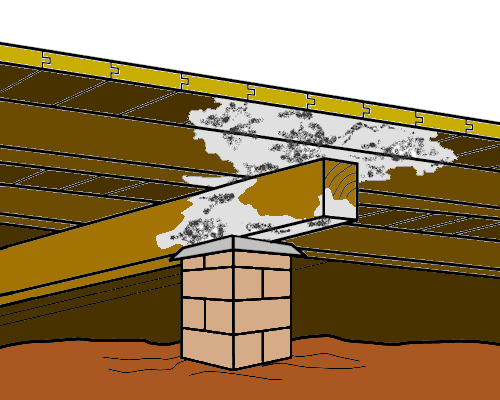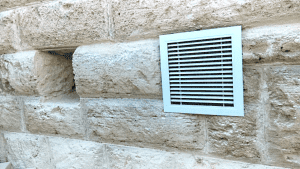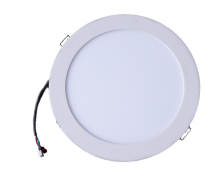Last Updated on July 21, 2025 by Solar Whiz
When it comes to maintaining a healthy Australian home, subfloor ventilation is often overlooked, yet it plays a crucial role in preventing long-term structural and health problems. Poor subfloor ventilation can lead to excessive moisture build-up, which in turn encourages mould growth, timber rot, and even termite infestations. These issues not only damage your home but can also impact your family’s health.
At Solar Whiz, we’ve worked with hundreds of homeowners across Australia to resolve subfloor dampness issues through tailored solar-powered ventilation systems. If you’re noticing strange smells, warped floorboards, or musty air in your home, your subfloor could be the hidden culprit.
In this guide, we’ll explain the common causes, warning signs, and effective long-term solutions for poor subfloor ventilation, so you can take action before the damage spreads.
The Risks Associated with Poor Sub-floor Ventilation
The negative consequences of poor airflow in the subfloor will be felt throughout the house in homes without any sub floor ventilation or with insufficient ventilation systems. The main effect of inadequate ventilation is that it traps humidity in the subfloor space, where it can readily spread throughout the house.
Mould can grow in the subfloor if there is a build-up of moisture there. Mould growth is clinically proven to cause a wide range of diseases and allergic reactions that necessitate rapid medical attention, in addition to harming the structure of the building. Moreover, mould’s awful appearance and smell can easily ruin the atmosphere within any home.
If your subfloor stays wet or damp for a long time, it can cause the wooden parts of your building to expand. This leads to the floors becoming warped, bent, and eventually completely ruined. Not only does this require costly repairs, but it also makes the building highly susceptible to termite infestations.
Common Causes of Poor Subfloor Ventilation
Several factors contribute to poor airflow and high humidity in the subfloor area. The most common causes include:
-
Inadequate airflow design: Older homes may not have enough passive vents to allow proper cross-ventilation.
-
Blocked vents: Plants, garden beds, or recently built patios and paths can block ventilation points.
-
Rising damp or poor drainage: Groundwater or stormwater pooling around the foundation can seep into the subfloor.
-
Obstructions inside vents: Cavity wall insulation or pests may block air circulation.
-
Insufficient clearance: Low-clearance subfloors reduce air movement and trap moisture easily.
Warning Signs of Poor Subfloor Ventilation

It’s not always easy to tell what’s happening under your floors, but these are the most common red flags:
-
Persistent musty or damp smell inside the house
-
Visible mould or mildew on skirting boards or lower walls
-
Condensation on windows, even in mild weather
-
Warped, cupping, or lifting floorboards
-
Faded or bubbling wall paint from moisture seeping upward
-
Increased allergy or asthma symptoms in the household
These signs may start mild but can become costly and hazardous if ignored.
How to Solve Subfloor Ventilation Problems
Improving your subfloor ventilation starts with identifying the source of excess moisture and ensuring effective airflow throughout the area.
1. Improve Drainage Around the Building
Ensure all stormwater and groundwater is directed away from the foundation. This includes checking downpipes, regrading soil, and extending drainage channels if needed.
2. Clear and Maintain Vents
Keep all existing passive vents free from blockages, vegetation, or debris. Consider increasing the number of vents if your home’s design limits cross-ventilation.
3. Fix Leaks and Plumbing Issues
Check for leaking pipes or taps beneath the house, which can introduce consistent dampness. Even slow leaks can cause major issues over time.
4. Remove Stored Items from Subfloor Areas
Stored objects can trap moisture and block air movement. Keep the space open and clutter-free for optimal ventilation.
5. Install Solar-Powered Subfloor Ventilation Fans
Solar-powered fans are a reliable, energy-efficient way to actively remove damp air from under your home. At Solar Whiz, we offer a range of solar subfloor fans that:
-
Operate cost-free using solar energy
-
Extract up to 3,000 m³/h of humid air
-
Require no roof modifications
-
Offer hybrid options (solar + mains power for night use)
-
Can be installed with an optional hygrostat to monitor humidity and activate the fan only when needed
These smart systems are quiet, low-maintenance, and highly effective, and they work year-round, including during cooler months when moisture can accumulate even faster.
Real Case: How a Client Beat Subfloor Dampness
One of our Melbourne clients contacted us after battling mould, warped floors, and strong odours for over a year. A site inspection revealed blocked passive vents and high subfloor humidity.
We installed two Solar Whiz AU-W-28 fans with a hygrostat controller. Within weeks, moisture readings dropped dramatically, and the homeowner reported fresher indoor air and no further mould growth.
“I wish we had done this sooner. It’s made such a difference — the house smells better, and no more creaky floors!” — Solar Whiz customer, VIC
Why Choose Solar Whiz for Subfloor Ventilation?
✅ Over 15 years of experience in Australian ventilation
✅ Tailored solutions for every home– no two are alike
✅ Local support and after-sales service
✅ Trusted by thousands of homeowners across the country
Learn more about our Solar Whiz Subfloor Ventilation Fans and how they can protect your home from the ground up.
Let us help you achieve a healthier and more comfortable living space. Enquire now!
Quote Request
Quote Request
View Our
Frequently Asked Questions
What are the dangers of poor subfloor ventilation?
Poor subfloor ventilation can lead to mould growth, timber rot, and rising damp. Over time, this affects your home’s structure and can harm your health, especially if anyone in the home has asthma or allergies.
How can I tell if I need a subfloor ventilation system?
You need a subfloor ventilation system if you’re noticing signs like persistent musty odours, mould on walls, or warped and cupping floorboards. These issues often point to high subfloor humidity. A professional inspection can confirm whether poor ventilation is the underlying cause.
Are solar subfloor fans better than powered systems?
Yes. Solar Whiz subfloor fans are a superior alternative to traditional powered systems. They’re energy-efficient, eco-friendly, and run during the day using solar power. With an optional night operation kit, Solar Whiz fans can continue ventilating even after sunset, helping maintain consistent airflow and moisture control.




